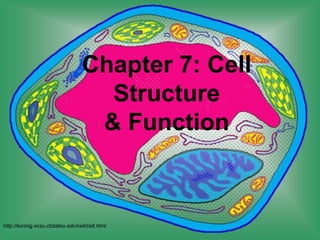
Chap_7Cell_structure_function1.ppt
- 1. Chapter 7: Cell Structure & Function http://koning.ecsu.ctstateu.edu/cell/cell.html
- 2. Discovery of Cells • Robert Hooke (1600’s) discovered “little chambers” (cells) in cork plant • Anton van Leeuwenhoek (1600’s)used microscope to view living things in pond water. Saw things swimming around!
- 3. Discovery of Cells, cont. • Matthias Schleiden (1838) concluded plants made of cells • Thoedor Schwann (1839) concluded all animals made of cells
- 4. Cell Theory 1. All living things are made up of cells. 2. Cells are the smallest working units of all living things. 3. All cells come from preexisting cells through cell division.
- 5. Definition of Cell A cell is the smallest unit that is capable of performing life functions.
- 6. Examples of Cells Amoeba Proteus Plant Stem Red Blood Cell Nerve Cell Bacteria
- 7. Two Types of Cells •Prokaryotic “pro-” means “before” (like “pre”) “karyon” means “nut” or kernel” No nucleus •Eukaryotic “eu-” means “true” Has nucleus
- 8. Prokaryotic • Do not have organelles surrounded by membranes • Few internal structures • One-celled organisms, Bacteria http://library.thinkquest.org/C004535/prokaryotic_cells.html
- 9. Eukaryotic • Contain organelles surrounded by membranes • Most living organisms Plant Animal http://library.thinkquest.org/C004535/eukaryotic_cells.html
- 14. Cell Membrane • Outer membrane of cell that controls movement in and out of the cell • Double layers of fat “”phospholipid bilayer” http://library.thinkquest.org/12413/structures.html
- 15. Cell Wall • Most commonly found in plant cells & bacteria & fungi • Supports & protects cells • Made of carbohydrate http://library.thinkquest.org/12413/structures.html
- 16. Inside the Cell
- 17. Nucleus • Directs cell activities • Separated from cytoplasm by nuclear membrane • Contains genetic material - DNA
- 18. Nuclear Membrane • Surrounds nucleus • Made of two layers • Openings allow material to enter and leave nucleus http://library.thinkquest.org/12413/structures.html
- 19. Chromatin • Form DNA takes most of the time. • Like spaghetti • Made of DNA wrapped up w/proteins
- 20. Chromosomes • In nucleus • DNA wrapped up tight by proteins called “histones” • Contain instructions for traits & characteristics http://library.thinkquest.org/12413/structures.html
- 21. Nucleolus • Inside nucleus • Contains RNA to build proteins http://library.thinkquest.org/12413/structures.html
- 22. Cytoplasm • Gel-like mixture • Surrounded by cell membrane • Contains hereditary material in prokaryotes
- 23. Ribosomes • Each cell contains thousands • Make proteins • Found on endoplasmic reticulum & floating in the cytoplasm http://library.thinkquest.org/12413/structures.html
- 24. Endoplasmic Reticulum • Moves materials around in cell • Smooth type: lacks ribosomes • Rough type (pictured): ribosomes embedded in surface http://library.thinkquest.org/12413/structures.html
- 25. Mitochondria • Produces energy through chemical reactions – breaking down fats & carbohydrates • Controls level of water and other materials in cell • Recycles and decomposes proteins, fats, and carbohydrates http://library.thinkquest.org/12413/structures.html
- 26. Golgi Bodies • Protein 'packaging plant' • Move materials within the cell • Move materials out of the cell http://library.thinkquest.org/12413/structures.html
- 27. Lysosome • Digestive 'plant' for proteins, fats, and carbohydrates • Transports undigested material to cell membrane for removal • Cell breaks down if lysosome explodes http://library.thinkquest.org/12413/structures.html
- 28. Vacuoles • Membrane-bound sacs for storage, digestion, and waste removal • Contains water solution • Help plants maintain shape http://library.thinkquest.org/12413/structures.html
- 29. Chloroplast • Usually found in plant cells (not in animal) • Contains green chlorophyll • Where photosynthesis takes place http://library.thinkquest.org/12413/structures.html
- 30. Centrioles • Used during animal cell division (not present in plant & most other cells)
- 31. Prokaryotic Cells • Ribosomes • DNA or RNA • cytoplasm
- 32. Cell Boundaries • Cell Membrane 1. Controls what goes in & out 2. Support & protection • Cell Wall 1. Support & protection
- 33. Diffusion through Cell Boundaries • Every cell lives in a liquid environment • Membrane controls movement of dissolved molecules back & forth (in & out of cell) • (Remember a solution contains a – Solvent: the substance that dissolves the other stuff (often water) – solute: the substance that gets dissolved (salt, sugar, ions, etc.)
- 34. Concentration of Solutions • The greater the ratio of solute to solvent, the higher the concentration. • Ex: • Solution #1: dissolve 5 g of salt in 1L of water. Concentration= 5g/L • Solution #2: dissolve 10 g of salt in 1L of water. Concentration=10g/L
- 35. Diffusion • In solution, particles move constantly, colliding & spreading out. • Diffusion is the movement of particles from area of greater to lesser concentration (b/c of random motion.) • Requires no energy to move substances across a membrane (b/c moved by random motion)
- 36. Equilibrium • When solute concentration is equal throughout the solution
- 37. Osmosis • The diffusion of water through a membrane • Some molecules are too large to move through a membrane
- 38. How Osmosis Works see Fig 7-15 on p 185 • If there is a selectively permeable membrane separating 2 solutions w/differing concentrations of solute, • Water will move from the side where it is in greater concentration to where it is in lesser concentration. (R to L in picture)
- 39. Concentration of Solutions • Isotonic: when the concentration of particles is the same on both sides of membrane • Hypertonic: “above strength”- the stronger of the 2 solutions (L side) • Hypotonic: “below strength”- the less concentrated of the 2 solutions (R side)
- 40. How Osmosis Works in Cells see p 186 of text, Fig 7-16 • Isotonic: Cell maintains its shape • Hypertonic